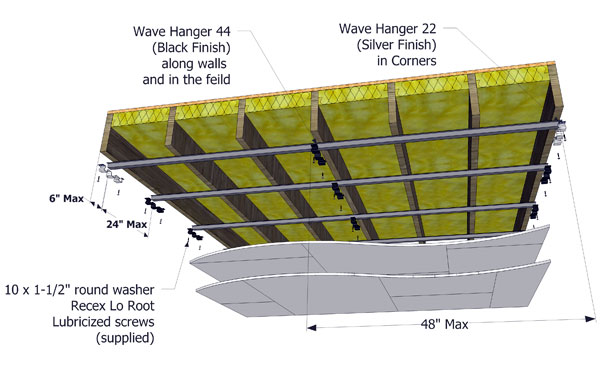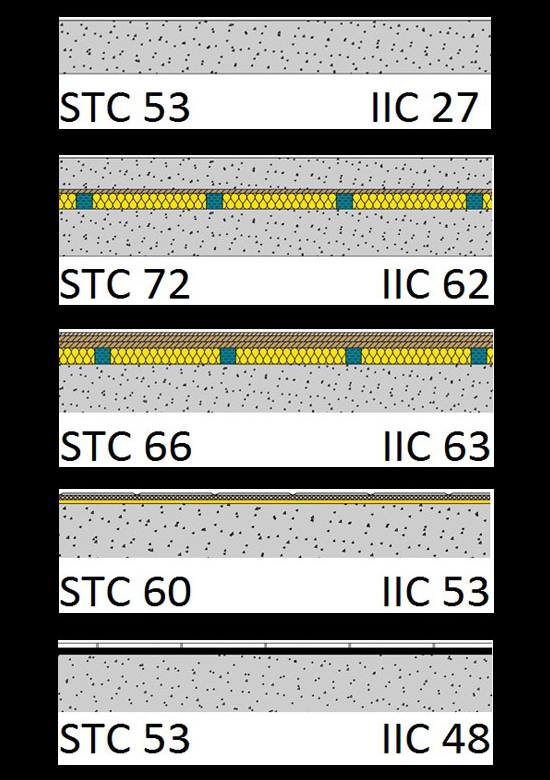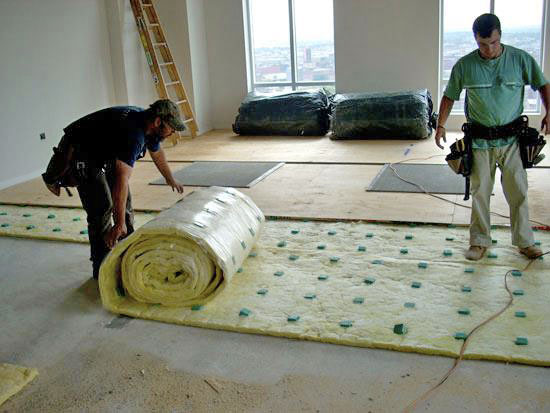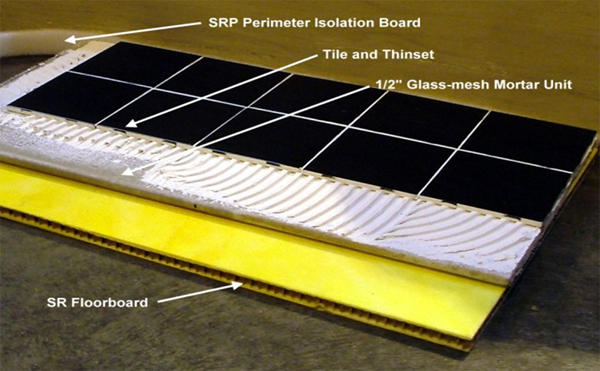Noise Control and Isolation for Multi-Family/Mixed Use Construction
Wood Frame Construction: Ceilings
Spring isolation hangers. These are best for lower frequency noise control. Secured to wood-frame construction (e.g., joists, trusses), a typical hanger incorporates a one-inch-rated deflection spring in series with a neoprene cup, and will typically support two or more layers of gypsum board.
Leaf spring hanger. An innovative approach, the leaf spring ceiling hanger out-performs a resilient channel for wood-framed projects with or without gypsum concrete. The leaf spring design delivers effective noise control for annoying lower frequencies.

Images courtesy of Kinetics Noise Control
Noise control options for wood frame ceilings.
Top and middle: 1in. coil spring will meet building codes.
Bottom: ½ in. leaf spring hanger with underlayment provides STC of 60 and IIC of 57.

Drawing courtesy of Kinetics Noise Control
Construction details for installing a leaf spring hanger.
Concrete Deck: Floors
Relativity stiff and massive concrete floors still can have poor, less than code, impact ratings. With no additional sound isolation system, a 6-inch concrete slab has an STC of 53 and an IIC of 27, so treatment of at least the impact noise is necessary to meet code.
Adding properly engineered resilient materials in the middle of the floor/ceiling sandwich will increase STC and IIC.

Images courtesy of Kinetics Noise Control
Options for ceiling noise control in concrete construction.
Top: Concrete construction with no noise control
Second from top: Creating a true air space with insulation sandwiched between concrete.
Third from top: Creating a true air space with wood floor on top instead of concrete.
Second from bottom: Continuous floor underlayment.
Bottom: Continuous low-profile floor underlayment, sometimes manufactured from recycled tires.
Roll-out isolation material. One typical roll-out isolation system creates an airspace of one to four inches with resilient isolators spaced according to design criteria. The roll-out isolation material can be installed beneath a “floated” concrete slab or other built up floor system utilizing cross-laid plywood sheathing. Installed between concrete slabs, the assembly STC and IIC can be 72 and 62 respectively. These values surpass the performance of continuous underlayments due to the airspace and lower natural frequency created by the isolators. While not typically used throughout residential units, this systems is used in gymnasiums and shared theater spaces in larger condominiums towers and similar projects.

Image courtesy of Kinetics Noise Control
A concrete slab covered in roll-out isolation material with resilient pads supporting a plywood and hardwood finish floor increases STC to 66 from 53 and IIC to 63 from 27.
Low profile underlayment. While having lower STC and IIC values than 1-to 4-inch-thick pads and batting, low profile resilient underlayments are a lower cost material primarily designed to improve the impact noise rating (IIC). If used directly under gypsum concrete, ceramic tile, wood, and vinyl sheet can meet and exceed building code for impact noise. It can facilitate construction of low-profile floor system in multi-family dwellings.

Image courtesy of Kinetics Noise Control
Floor assembly (without ceiling) including a sound control layer of 5/8-in.-thick mat on concrete yields an STC and IIC of 59.
Recycled rubber. One environmentally friendly noise control low profile floor underlayment is 98 percent post-consumer and post-industrial recycled rubber. A 3 mm underlayment beneath hard flooring and on top of a 6 in. concrete slab can achieve STC and IIC values of 50 each. The Delta IIC test measures IIC improvement with the use of underlayments compared with a bare 6 in. concrete slab.









